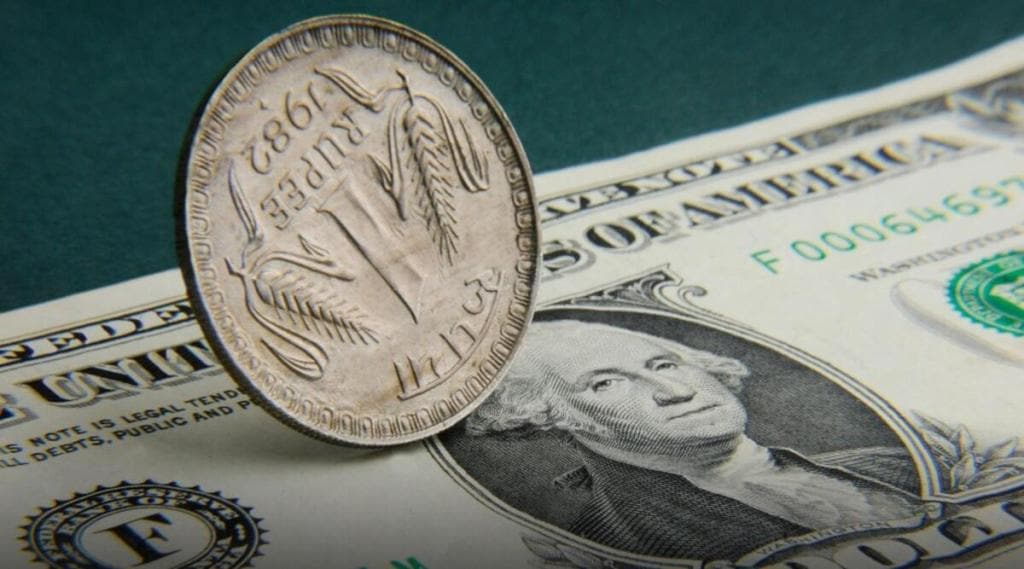On a downward streak tracking its Asian peers, the rupee dropped below the key 80-mark against the dollar in early intra-day trade on Tuesday, heightening concerns over exchange rate depreciation exerting a net adverse impact on India’s relatively sound macroeconomic fundamentals and impeding an economic recovery.
The Indian currency recouped losses later to close at 79.94, registering a rise of 6 paise over its previous close, thanks to the Reserve Bank of India’s interventions in both the spot and forward currency markets and a rebound in stocks. Though the rupee may hold in the near term with some amount of volatility, a further fall is seen by most analysts in the weeks ahead.
The US Federal Reserve is widely expected to go for a steep rate hike later this month, impelling investors to forego riskier assets.
The rupee being weak against the greenback, in which over 60% of the country’s external trade is denominated, would stoke imported inflation, exacerbate the trade and current account deficits, accentuate capital outflows, constrict margins of sections of Corporate India and strain government finances in assorted ways.
Where and how the effects of the falling currency will be more pronounced will depend on the government’s priorities — for instance, the inflation impact will depend on the extent of pass-through of international commodity prices to the domestic market via higher fuel and power prices.
To be sure, the rupee’s fall has much less to do with the economy’s intrinsic problems, than the greenback’s consolidation against most currencies, even in the face of an impending US recession, thanks to its reserve currency status. Since the local unit has gained against a basket of other prominent currencies including the euro, the British pound and Japanese yen in recent months, adverse effects of its persisting weakness against the dollar will be offset to some extent.
Also, a weak rupee will firm up the margins of India’s IT companies, which are export-intensive.
In a written reply in Parliament, the finance ministry said the government and the central bank were closely monitoring domestic inflation and “stand ready to take appropriate action”. However, some analysts cautioned that aggressive interventions to defend the rupee could be counter-productive. Such a stance by the RBI could build expectations among foreign portfolio investors that the Indian currency will decline as and when it eases to intervene, they noted.
One view is that with the dollar likely to remain relatively strong in the immediate term, the rupee may weaken to 81/dollar or thereabouts in Q2FY23. Global developments, primarily the severity of the US recession/ slump and the direction of FPI flows, will determine the rupee’s trajectory in the rest of the financial year.
The RBI has recently taken a slew of steps to arrest the fall of the rupee, including allowing overseas investors to buy short-term corporate debt and placing more government securities under the fully accessible route. It also allowed importers and exporters to be paid in rupees to reduce the demand for dollars among traders, but a severe dollar shortage is still being felt.
The possibility of the European Central Bank raising interest rates for the first time in 11 years on Thursday, caused the dollar index to slip to one-week lows on Monday against the basket of currencies. Analysts expect the dollar index to remain volatile this week and face steep resistance around 109.00 levels. It is pertinent to note that despite profit taking in the dollar index, the rupee slipped again, having been impacted by a rise in crude oil prices. “We expect the rupee to remain volatile this week and could hold its key support level of 80.55 on a closing basis,” Rahul Kalantri, VP Commodities, Mehta Equities, wrote.
“Expectation is that the Fed could raise rates by another 75bps and maintain a hawkish stance. On the domestic front, trade deficit continues to widen and that also is weighing on the rupee. We expect the USDINR (spot) to trade with a positive bias and quote in the range of 79.70 and 80.20,” Gaurang Somaiya, forex & bullion analyst at Motilal Oswal Financial Services wrote. According to Nomura, the rupee might fall to 82 in the September quarter.
While India’s merchandise trade deficit remained elevated in recent months, much of it was caused by the rise in oil prices and jump in imports of industrial inputs like coal. Consequent to high trade deficit, the current account deficit in FY23 is seen to widen to 3% of GDP in FY23 from a benign 1.2% in FY22. Worse, this comes at a time when continued FPI outflows have made analysts to prune estimates of capital account surplus this year by $15-20 billion to about $60-65 billion.
While a weak rupee and capital flight can potentially feed each other, creating a vicious cycle, currency depreciation will also have a telling impact on imported inflation, to which India is vulnerable, because almost half of the imports are price inelastic.
The wholesale price inflation, which has been in double digits for 15 months in row, could fan consumer price inflation, making the task of the Monetary Policy Committee harder. Retail inflation remained above the upper band of the RBI’s medium-term target for the sixth straight month in June, when the print came in at 7.01%.

